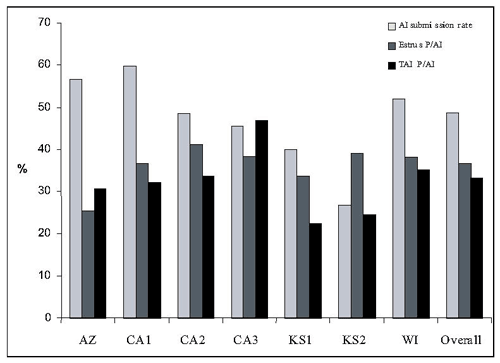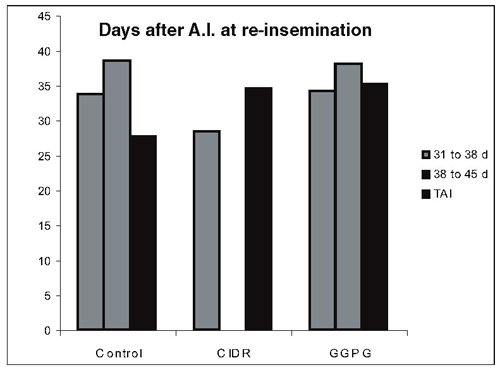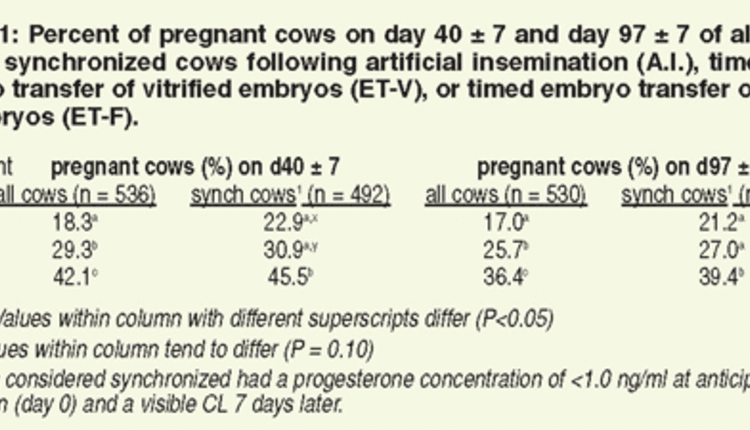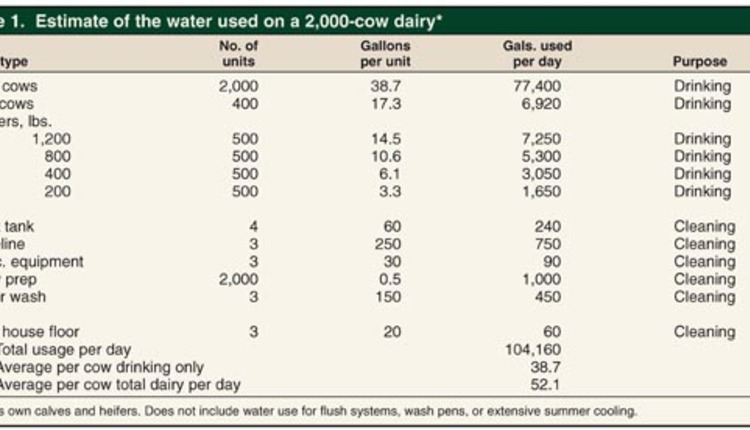By Todd R. Bilby, Ph.D.,Texas A&M University, Ricardo C. Chebel, D.V.M and John Fetrow, D.V.M., University of Minnesota
Since the advent of A.I. synchronization programs in the early 1990s, many producers now use reproductive hormones to manipulate the estrous cycle of cows in order to time ovulation and insemination and get them pregnant in a timely manner.
Reproductive failure is the first reason for involuntary culling, which stresses the economic importance of getting cows bred in a timely manner. Much research has been conducted on the timing of hormonal injections in order to achieve the highest fertility possible from a timed A.I. (TAI) program. However, sometimes this is at the expense of what is realistically achievable and applicable on modern dairy operations. Furthermore, TAI might not be the best solution for improving fertility.
During the first post partum synchronization and TAI, much flexibility is allowed in the timing and type of injections (i.e. prostaglandin (PG) F2a) used in order to achieve acceptable pregnancy rates to a TAI program. For example, many producers use a presynchronization program (two shots of PG 14 days apart) 10 to 14 days prior to the start of a TAI program such as the Ovsynch protocol (day 0 – GnRH, day 7 – PG, day 9 – GnRH, and day 10 – TAI) or a variation thereof (i.e. Cosynch 72).
This has two major advantages:
1. A producer can breed cows off estrus after the second PG injection, thus reducing the number of cows that enter the TAI program and significantly reducing costs.
2. By using presynchronization the cows that didn't show heat should be in the correct stage of their estrous cycle (i.e. days 5 to 9) to achieve the highest fertility to the TAI program.
In a recent study conducted with 3,248 lactating cows in seven large dairy herds across the U.S., cows were presynchronized with two injections of PG and those observed in estrus were inseminated. Cows not observed in estrus were submitted to a TAI protocol (i.e. Ovsynch or Cosynch72). These herds were a mix of dry-lot (AZ and CA) and free stall (remaining herds). Average days in milk at first A.I. were 58.3 (±0.2) for cows inseminated in estrus, and 73.3 (±0.2) for cows inseminated at fixed TAI. The average A.I. submission rate (proportion of cows inseminated in estrus after the second PG injection) was 48.7 percent, with a range from 26.7 to 59.8 percent.
In 5 out of 7 herds in this experiment, pregnancies per A.I. (P/AI – proportion of cows pregnant divided by the number of cows inseminated) was numerically greater than that of cows inseminated at fixed TAI.
When data from 5 different studies conducted in 4 different farms in California were combined, the P/AI of cows inseminated at estrus after the presynchronization protocol (i.e two shots of PG 14 days apart) was approximately 2.5 percentage units greater than those inseminated at fixed TAI (34.9 vs. 32.5 percent). Other studies have demonstrated a slight increase in P/AI of cows inseminated at fixed TAI compared with those inseminated at estrus (28.3 vs. 31.5 percent).
When dealing with re-insemination of non-pregnant cows, abandoning estrus detection and relying solely on TAI seems to be the wrong decision for several reasons.
Although with the use of ultrasound non-pregnant cows can be diagnosed as early as 25 days after AI, most veterinarians would agree that this is not a practical procedure when dealing with a large number of cows. Therefore, even with the use of ultrasound, non-pregnant cows would normally be diagnosed 29 to 32 days after A.I. at the earliest, and would only be re-inseminated at 32 to 35 days after A.I., depending on the resynchronization protocol used.
However, only 27 percent of herds in the U.S. use ultrasound for pregnancy diagnosis, so the majority would not diagnose pregnancy earlier than 35 days after A.I. With a double Ovsynch program, the minimum time from one breeding to the next is 49 days (2.33 estrus cycles), so the maximum effective A.I. submission rate would be 43 percent. Consequently, for a pregnancy rate of 20 percent to be achieved in these resynchronized cows, P/AI would have to be at least 47 percent.
In a recent study conducted in Arizona and California, cows were submitted to different resynchronization protocols at approximately 31 days after A.I.
One-third of cows received a GnRH injection a week before pregnancy exam, and if diagnosed open they received a second GnRH, followed 7 days later by a PG shot, and 3 days later GnRH + TAI (GGPG).
One-third of the cows did not receive any treatment until pregnancy diagnosis, and if diagnosed open they received GnRH, followed 7 days later by a PG, and 3 days later GnRH + TAI (control).
The third and last group of cows (CIDR), also were only treated after being diagnosed open but they received a CIDR insert along with the first GnRH injection (GnRH + CIDR, followed 7 days later by a PG and CIDR removal, and 3 days later GnRH + TAI).
In the California herd, all cows enrolled in the study one week before pregnancy diagnosis were followed even if they were re-inseminated in estrus after enrollment or after non-pregnancy diagnosis. Therefore, in California we collected P/AI data of cows re-inseminated on estrus from enrollment to pregnancy diagnosis (31 to 38 days after A.I.), from open diagnosis to PG injection (38 to 45 days after A.I.) and from cows inseminated after the PG injection (TAI).
A total of 23.2 percent of cows in the control and CIDR groups were re-inseminated on estrus from 31 to 38 days after A.I., but only 13.9 percent of cows in the GGPG group were re-inseminated in this interval. From 38 to 45 days after A.I., 10.7 percent of control, 0.3 percent of CIDR, and 6.9 percent of GGPG cows were re-inseminated. Finally, the proportions of cows receiving TAI were 69.1, 72.9, and 79.2 percent for control, CIDR, and GGPG cows, respectively.
Obviously, the interval from enrollment to re-insemination was significantly smaller for cows re-inseminated from 31 to 38 days after A.I. (3.4 ± 0.1d), followed by cows re-inseminated from 38 to 45 days after A.I. (11.5 ± 0.2d), and cows re-inseminated at fixed TAI (16.4 ± 0.1d. As observed in figure 2, control cows re-inseminated on estrus had greater P/AI than those inseminated at TAI. CIDR cows had slightly better P/AI when inseminated at TAI compared to those inseminated on estrus. Finally, GGPG cows inseminated on estrus had similar P/AI to those inseminated at TAI.

Figure 1: A.I. submission rate and pregnancy per A.I. (P/AI) of cows inseminated on estrus (Estrus) or timed A.I. (TAI). All cows were presynchronized with the Presynch protocol, and those not observed in estrus within 12 to 14 days after the last PG injection of the Presynch were enrolled in a TAI protocol.

Figure 2: Pregnancies per A.I. (P/AI) of cows submitted to different resynchronization protocols and re-inseminated at different intervals after enrollment.
Considering that P/AI of cows re-inseminated on detected estrus was better or slightly less than those inseminated on fixed TAI, but cows re-inseminated in estrus had an interval from enrollment to re-insemination approximately 5 to 13 days shorter than cows submitted to TAI, it becomes obvious that abandoning heat detection and relying solely on TAI programs would be a mistake.
The economic dimension of any decision on a dairy, including the choice of reproductive programs, is inherently dependent on a variety of conditions including current and projected prices and the variations in biological response. This makes "hard and fast" recommendations for all dairies impossible and likely dangerous.
With that warning understood, over a range of reasonable general assumptions, estrous detection efforts that can be added into the interval between timed A.I. inseminations will usually serve to reduce average days open and be more profitable than a program of only timed AI. For a breeding program based only on estrous detection to be more profitable than a program that includes at least some estrus synchronization, the estrus detection rate in the "observation only" program probably must exceed at least 50 percent.
Failure to detect estrus is one of the most common and costly problems of reproductive programs and one of the major limiting factors for improved reproductive performance. Approximately, half of all heats are undetected on dairies in the U.S. In addition, research has shown that up to 15 percent of cows presented for insemination are not in heat. Failure to efficiently detect cows in heat, and breeding cows not in heat, results in significant economic loss.
As dairy herds have increased in size, adequate time to visually observe estrus on all cows eligible has been reduced. In addition, increased milk production and flooring consisting of concrete instead of dirt has reduced time and length of estrus expression. Table 1 below illustrates the effect of dirt versus concrete surfaces on estrus in lactating cows.
Table 1: Estrous activity on dirt versus concrete surfaces.

Although a TAI program is important for insuring that all cows are inseminated by a certain days in milk, treating anovular conditions, and catching the cows that were not caught in heat prior to the TAI program, it is still advantageous to breed off heat when possible.
Several heat detection methods are available to improve the accuracy and number of cows detected in estrus, such as visual observation, tail chalk, heat mount patches, heat watch system, and pedometers (or other activity monitors). To improve heat detection efficiency and accuracy, use a combination of two or more methods to aid in improving your estrus detection.
Below are a few tips:
1. Utilizing visual observations and tail chalk is a fairly cheap and easy way to improve estrus detection. Visual observation should occur at least two to three times per day for 20 minutes each occurring early in the morning and late in the evening. Seventy percent of cows show heat between 7 p.m. and 7 a.m.
2. Utilize your herd records to see when the cow was last in estrus to ensure accuracy of heat detection.
3. Use secondary signs as another aid in accurately identifying cows in heat.
4. Estrous expression is reduced in the summer, and in cows that spend the majority of their time on concrete (i.e. free stall vs. open drylot), so be as aggressive as possible with identifying cows in estrus.
5. Heat detection technology requires judicious management and interpretation by knowledgeable cow people. The tested and proven "eyeball" technique requires cow watching time and sound judgment.
6. Make sure your reproduction protocol does not limit or reduce heat detection.
No matter what technique is employed, success of heat detection programs requires dedicated, observant people. Heat detection aids and TAI programs should never be used as a crutch, but as a tool. About 10 percent of the reasons for failure to detect heats can be attributed to cow problems and 90 percent to management problems. Improving your heat detection efficiency will, in turn, improve your bottom line.
Click here to return to the Reproduction E-Sources
0912_W171
Since the advent of A.I. synchronization programs in the early 1990s, many producers now use reproductive hormones to manipulate the estrous cycle of cows in order to time ovulation and insemination and get them pregnant in a timely manner.
Reproductive failure is the first reason for involuntary culling, which stresses the economic importance of getting cows bred in a timely manner. Much research has been conducted on the timing of hormonal injections in order to achieve the highest fertility possible from a timed A.I. (TAI) program. However, sometimes this is at the expense of what is realistically achievable and applicable on modern dairy operations. Furthermore, TAI might not be the best solution for improving fertility.
During the first post partum synchronization and TAI, much flexibility is allowed in the timing and type of injections (i.e. prostaglandin (PG) F2a) used in order to achieve acceptable pregnancy rates to a TAI program. For example, many producers use a presynchronization program (two shots of PG 14 days apart) 10 to 14 days prior to the start of a TAI program such as the Ovsynch protocol (day 0 – GnRH, day 7 – PG, day 9 – GnRH, and day 10 – TAI) or a variation thereof (i.e. Cosynch 72).
This has two major advantages:
1. A producer can breed cows off estrus after the second PG injection, thus reducing the number of cows that enter the TAI program and significantly reducing costs.
2. By using presynchronization the cows that didn't show heat should be in the correct stage of their estrous cycle (i.e. days 5 to 9) to achieve the highest fertility to the TAI program.
In a recent study conducted with 3,248 lactating cows in seven large dairy herds across the U.S., cows were presynchronized with two injections of PG and those observed in estrus were inseminated. Cows not observed in estrus were submitted to a TAI protocol (i.e. Ovsynch or Cosynch72). These herds were a mix of dry-lot (AZ and CA) and free stall (remaining herds). Average days in milk at first A.I. were 58.3 (±0.2) for cows inseminated in estrus, and 73.3 (±0.2) for cows inseminated at fixed TAI. The average A.I. submission rate (proportion of cows inseminated in estrus after the second PG injection) was 48.7 percent, with a range from 26.7 to 59.8 percent.
In 5 out of 7 herds in this experiment, pregnancies per A.I. (P/AI – proportion of cows pregnant divided by the number of cows inseminated) was numerically greater than that of cows inseminated at fixed TAI.
When data from 5 different studies conducted in 4 different farms in California were combined, the P/AI of cows inseminated at estrus after the presynchronization protocol (i.e two shots of PG 14 days apart) was approximately 2.5 percentage units greater than those inseminated at fixed TAI (34.9 vs. 32.5 percent). Other studies have demonstrated a slight increase in P/AI of cows inseminated at fixed TAI compared with those inseminated at estrus (28.3 vs. 31.5 percent).
When dealing with re-insemination of non-pregnant cows, abandoning estrus detection and relying solely on TAI seems to be the wrong decision for several reasons.
Although with the use of ultrasound non-pregnant cows can be diagnosed as early as 25 days after AI, most veterinarians would agree that this is not a practical procedure when dealing with a large number of cows. Therefore, even with the use of ultrasound, non-pregnant cows would normally be diagnosed 29 to 32 days after A.I. at the earliest, and would only be re-inseminated at 32 to 35 days after A.I., depending on the resynchronization protocol used.
However, only 27 percent of herds in the U.S. use ultrasound for pregnancy diagnosis, so the majority would not diagnose pregnancy earlier than 35 days after A.I. With a double Ovsynch program, the minimum time from one breeding to the next is 49 days (2.33 estrus cycles), so the maximum effective A.I. submission rate would be 43 percent. Consequently, for a pregnancy rate of 20 percent to be achieved in these resynchronized cows, P/AI would have to be at least 47 percent.
In a recent study conducted in Arizona and California, cows were submitted to different resynchronization protocols at approximately 31 days after A.I.
One-third of cows received a GnRH injection a week before pregnancy exam, and if diagnosed open they received a second GnRH, followed 7 days later by a PG shot, and 3 days later GnRH + TAI (GGPG).
One-third of the cows did not receive any treatment until pregnancy diagnosis, and if diagnosed open they received GnRH, followed 7 days later by a PG, and 3 days later GnRH + TAI (control).
The third and last group of cows (CIDR), also were only treated after being diagnosed open but they received a CIDR insert along with the first GnRH injection (GnRH + CIDR, followed 7 days later by a PG and CIDR removal, and 3 days later GnRH + TAI).
In the California herd, all cows enrolled in the study one week before pregnancy diagnosis were followed even if they were re-inseminated in estrus after enrollment or after non-pregnancy diagnosis. Therefore, in California we collected P/AI data of cows re-inseminated on estrus from enrollment to pregnancy diagnosis (31 to 38 days after A.I.), from open diagnosis to PG injection (38 to 45 days after A.I.) and from cows inseminated after the PG injection (TAI).
A total of 23.2 percent of cows in the control and CIDR groups were re-inseminated on estrus from 31 to 38 days after A.I., but only 13.9 percent of cows in the GGPG group were re-inseminated in this interval. From 38 to 45 days after A.I., 10.7 percent of control, 0.3 percent of CIDR, and 6.9 percent of GGPG cows were re-inseminated. Finally, the proportions of cows receiving TAI were 69.1, 72.9, and 79.2 percent for control, CIDR, and GGPG cows, respectively.
Obviously, the interval from enrollment to re-insemination was significantly smaller for cows re-inseminated from 31 to 38 days after A.I. (3.4 ± 0.1d), followed by cows re-inseminated from 38 to 45 days after A.I. (11.5 ± 0.2d), and cows re-inseminated at fixed TAI (16.4 ± 0.1d. As observed in figure 2, control cows re-inseminated on estrus had greater P/AI than those inseminated at TAI. CIDR cows had slightly better P/AI when inseminated at TAI compared to those inseminated on estrus. Finally, GGPG cows inseminated on estrus had similar P/AI to those inseminated at TAI.


Considering that P/AI of cows re-inseminated on detected estrus was better or slightly less than those inseminated on fixed TAI, but cows re-inseminated in estrus had an interval from enrollment to re-insemination approximately 5 to 13 days shorter than cows submitted to TAI, it becomes obvious that abandoning heat detection and relying solely on TAI programs would be a mistake.
The economic dimension of any decision on a dairy, including the choice of reproductive programs, is inherently dependent on a variety of conditions including current and projected prices and the variations in biological response. This makes "hard and fast" recommendations for all dairies impossible and likely dangerous.
With that warning understood, over a range of reasonable general assumptions, estrous detection efforts that can be added into the interval between timed A.I. inseminations will usually serve to reduce average days open and be more profitable than a program of only timed AI. For a breeding program based only on estrous detection to be more profitable than a program that includes at least some estrus synchronization, the estrus detection rate in the "observation only" program probably must exceed at least 50 percent.
Failure to detect estrus is one of the most common and costly problems of reproductive programs and one of the major limiting factors for improved reproductive performance. Approximately, half of all heats are undetected on dairies in the U.S. In addition, research has shown that up to 15 percent of cows presented for insemination are not in heat. Failure to efficiently detect cows in heat, and breeding cows not in heat, results in significant economic loss.
As dairy herds have increased in size, adequate time to visually observe estrus on all cows eligible has been reduced. In addition, increased milk production and flooring consisting of concrete instead of dirt has reduced time and length of estrus expression. Table 1 below illustrates the effect of dirt versus concrete surfaces on estrus in lactating cows.
Table 1: Estrous activity on dirt versus concrete surfaces.

Although a TAI program is important for insuring that all cows are inseminated by a certain days in milk, treating anovular conditions, and catching the cows that were not caught in heat prior to the TAI program, it is still advantageous to breed off heat when possible.
Several heat detection methods are available to improve the accuracy and number of cows detected in estrus, such as visual observation, tail chalk, heat mount patches, heat watch system, and pedometers (or other activity monitors). To improve heat detection efficiency and accuracy, use a combination of two or more methods to aid in improving your estrus detection.
Below are a few tips:
1. Utilizing visual observations and tail chalk is a fairly cheap and easy way to improve estrus detection. Visual observation should occur at least two to three times per day for 20 minutes each occurring early in the morning and late in the evening. Seventy percent of cows show heat between 7 p.m. and 7 a.m.
2. Utilize your herd records to see when the cow was last in estrus to ensure accuracy of heat detection.
3. Use secondary signs as another aid in accurately identifying cows in heat.
4. Estrous expression is reduced in the summer, and in cows that spend the majority of their time on concrete (i.e. free stall vs. open drylot), so be as aggressive as possible with identifying cows in estrus.
5. Heat detection technology requires judicious management and interpretation by knowledgeable cow people. The tested and proven "eyeball" technique requires cow watching time and sound judgment.
6. Make sure your reproduction protocol does not limit or reduce heat detection.
No matter what technique is employed, success of heat detection programs requires dedicated, observant people. Heat detection aids and TAI programs should never be used as a crutch, but as a tool. About 10 percent of the reasons for failure to detect heats can be attributed to cow problems and 90 percent to management problems. Improving your heat detection efficiency will, in turn, improve your bottom line.
0912_W171










